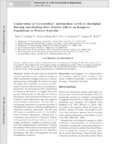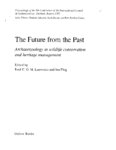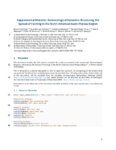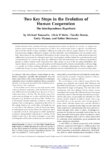Filters: School Or College: "College of Social & Behavioral Science" Collection: "ir_uspace" Type: "Text" Department: "Anthropology"
| Creator | Title | Description | Subject | Date | ||
|---|---|---|---|---|---|---|
| 76 |
 |
Codding, Brian | Conservation or co-evolution? Intermediate levels of aboriginal burning and hunting have positive effects on kangaroo populations in Western Australia | Studies of conservation in small scale societies typically portray indigenous peoples as either sustainably managing resources, or forsaking long-term sustainability for short-term gains. To explain this variability, we propose an alternative framework derived from a co-evolutionary perspective. In ... | 2014-01-01 | |
| 77 |
 |
Cashdan, Elizabeth A. | Waist-to hip ratio across cultures: trade-offs between androgen-and estrogen-dependent traits | A gynoid pattern of fat distribution, with small waist and large hips (low waist-to-hip ratio, or WHR) holds significant fitness benefits for women: women with a low WHR of about 0.7 are more fecund, are less prone to chronic disease, and (in most cultures) are considered more attractive. Why, then... | Fertility; Optimum; Fecundity | 2008 |
| 78 |
 |
Wiessner, Pauline W. | Vines of complexity - egalitarian structures and the institutionalization of inequality among the Enga | The initial stages of the institutionalization of hierarchical social inequalities remain poorly understood. Recent models have added important perspectives to "adaptationist" approaches by centering on the agency of "aggrandizers" who alter egalitarian institutions to suit their own ends through de... | Egalitarian structures; Political evolution; Social d | 2002-04 |
| 79 |
 |
Rogers, Alan R.; Harpending, Henry C. | Genetic structure of ancient human populations | Discusses mitochondrial DNA (mtDNA) sequences as important source of data about the history of human species. | Tree of descent; Mismatch distributions; Simulations; Findings; Intermatch distributions; Younger and older populations | 2001-09-15 |
| 80 |
 |
Rogers, Alan R. | Genetic evidence for a Pleistocene population explosion | Expansions of population size leave characteristic signatures in mitochondrial "mismatch distributions." Consequently, these distributions can inform us about the history of changes in population size. Here, I study a simple model of population history that assumes that, t generations before the pr... | 1995 | |
| 81 |
 |
O'Connell, James F. | A Different Paradigm for the Initial Colonisation of Sahul: Archaeological, genetic, demographic and geographic perspectives | The questions of when and how humans reached Sahul, the Pleistocene continent of Australia and New Guinea, has remained a central issue of Australian archaeology since its development as an academic discipline in the mid-twentieth century. Additionally, this has been a dominant theme linking Austral... | Sahul; Wallacea; colonisation; isolation; genomics; mitochondrial DNA | 2019-08-20 |
| 82 |
 |
Hawkes, Kristen | Hadza scavenging: implications for Plio/Pleistocene Hominid subsistence | The frequent association of stone tools and large animal bones in African Plio/Pleistocene archaeological sites has long been taken as evidence of the importance of hunting in early hominid diets. Many now argue that it reflects hominid scavenging, not hunting. | Hadza; Scavenging; Plio/Pleistocene; Hominid Diet | 1988-04 |
| 83 |
 |
Broughton, John | Size of the bursa of fabricius in relation to gonad size and age in laysan and black-footed albatrosses | Age determination can be difficult for birds that undergo little or no plumage change during life. This is the case for Laysan and Black-footed Albatrosses (Diomedea immutabilis and D. nigripes). The juvenile plumage for both these North Pacific albatrosses is completely grown by about five to six m... | Birds; Species; Development | 1994 |
| 84 |
 |
McElreath, Richard | Economic man in cross-cultural perspective: behavioral experiments in 15 small-scale societies | Since "Selfishness examined . . ." (Caporael et al. 1989) appeared in these pages, more than 15 years ago, many additional experiments have strongly confirmed the doubts expressed by Caporael and her collaborators concerning the adequacy of self-interest as a behavioral foundation for the social sci... | Economic outcomes; Selfishness; Fairness; Reciprocity | 2005 |
| 85 |
 |
McElreath, Richard | Social learning and the maintenance of cultural variation: an evolutionary model and data from East Africa | Human societies maintain between-group variation despite mixing of people and ideas. In order for variation to remain, migrants or their children must preferentially adopt local norms, customs, and beliefs. Yet the details of how cultural variation is maintained, despite mixing, remain unknown. This... | Cultural variation; cultural identity; East Africa | 2004 |
| 86 |
 |
Harpending, Henry C. | Paternal age and genetic load | The incidence of base substitutions in humans increases with the age of the father, which shows up as an increased incidence of mutational disorders in the children of older fathers. There is a less obvious implication: an extended period of high average paternal age in a population will lead to inc... | 2013-01-01 | |
| 87 |
 |
Broughton, John | Pristine benchmarks and indigenous conservation? Implications from California zooarchaeology | The superabundance of tame wildlife during the early historic period in California astonished European explorers. And the historic accounts of incredible animal densities, most notably artiodactyls, have influenced a long-held perception that California Indians lived in harmony with nature. However,... | 2004-01-01 | |
| 88 |
 |
Codding, Brian F. | Supplementary Materials: Socioecological dynamics structuring the spread of farming in the North American Basin-Plateau Region | This document includes the code used to complete the analysis presented in the manuscript "Socioecological Dynamics Structuring the Spread of Farming in the North American Basin-Plateau Region" in Environmental 15 Archaeology. | environmental archaeology | |
| 89 |
 |
Codding, Brian F. | Socioecological dynamics structuring the spread of farming in the North American Basin-Plateau Region | The spread of agriculture is a major driver of social and environmental change throughout 25 the Holocene, yet experimental and ethnographic data indicate that farming is less profitable than foraging, so why would individuals choose to adopt agriculture leading to its expansion? Ideal distribution ... | Ideal free distribution model; population ecology; behavioral ecology; maize agriculture; Ancestral Puebloan; Fremont Complex | 2021 |
| 90 |
 |
Broughton, John | Terminal Pleistocene fish remains from Homestead Cave, Utah, and implications for fish biogeography in the Bonneville Basin | Eleven fish species were identified from Homestead Cave, Utah. The remains, concentrated in the lowest stratum of the deposit, were accumulated by owls between approximately 11,200 and 10,100 14C yr B.P. and likely represent fish associated with the final die-off of the Lake Bonneville fauna. Fou... | Fish assemblage; Quaternary; Lake Bonneville | 2000 |
| 91 |
 |
O'Rourke, Dennis H. | Ascertainment bias for non-twin relatives in twin proband studies | When families are ascertained through affected twins, as for example when twin probands are selected from a registry and their non-twin relatives studied, a correction for ascertainment bias is needed. It is shown that probandwise counting (where relatives of doubly ascertained twin pairs are counte... | Genetic; Transmission; Models | 1982 |
| 92 |
 |
Rogers, Alan R.; Jorde, Lynn B. | Genetic evidence on modern human origins | A review of genetic evidence leads to the following conclusions concerning human population history: (1) Between 33,000 and 150,000 years ago the human population expanded from an initial size of perhaps 10,000 breeding individuals, reaching a size of at least 300,000. (2) Although the initial popu... | Population history; Mitochondrial DNA; Mismatch distribution; Intermatch distribution; Replacement hypothesis; Population bottlenecks | 1995 |
| 93 |
 |
Rogers, Alan R.; Jorde, Lynn B. | Genetic structure of the Utah Mormons: comparison of results based on RFLPs, blood groups, migration matrices, isonymy, and pedigrees | The genetic structure of the Utah Mormon population is examined using 25 blood group and 47 RFLP alleles obtained from 442 subjects living in 8 geographic subdivisions. Nei's Gst was 0.013 (p < 0.002) for the RFLP data and 0.012 (p > 0.4) for the blood group data, showing that only 1% of the geneti... | 1994 | |
| 94 |
 |
Rogers, Alan R.; Jorde, Lynn B. | Modeling the amplification dynamics of human Alu retrotransposons | Retrotransposons have had a considerable impact on the overall architecture of the human genome. Currently, there are three lineages of retrotransposons (Alu, L1, and SVA) that are believed to be actively replicating in humans. While estimates of their copy number, sequence diversity, and levels of ... | Retrotransposons; Amplification dynamics; Mutation; Human-chimpanzee divergence | 2005 |
| 95 |
 |
Cashdan, Elizabeth A. | How women compete | Men are more physically aggressive and more risk-prone than women, but are not necessarily more competitive. New data show the gender difference in competitiveness to be one of kind rather than degree, with women and men competing in different ways and, to some extent, over different objectives, but... | Gender differences, behavior; Competition; Aggression | 1999-06 |
| 96 |
 |
Cashdan, Elizabeth A. | Technological change and child behavior among the !Kung | How does change in one part of a social system affect other parts? This is the central question that must be answered in order to understand the process through which culture changes. This paper is about a small piece of the problem. It investigates how changes in subsistence economy affect child be... | Child behavior; Technological change; Foraging groups; Settled groups | 1988 |
| 97 |
 |
Hawkes, Kristen | Human life histories: primate trade-offs, grandmothering socioecology, and the fossil record | Human life histories differ from those of other animals in several striking ways. Recently Smith and Tompkins (1995, p. 258) highlighted the combination of "slow" and "fast" features of human lives. Our period of juvenile dependency is unusually long, our age at first reproduction is late, and we h... | Meat; Maturity; Life Span | 2003 |
| 98 |
 |
McElreath, Richard | When natural selection favors imitation of parents | It is commonly assumed that parents are important sources of socially learned behavior and beliefs. However, the empirical evidence that parents are cultural models is ambiguous, and debates continue over their importance. A formal theory that examines the evolution of psychological tendencies to i... | Transmission; Evolution; Culture | 2008 |
| 99 |
 |
O'Rourke, Dennis H. | Introduction: origins and settlement of the indigenous populations of the Aleutian Archipelago | The series of papers in this special issue of Human Biology use an interdisciplinary approach to address regional questions and to integrate disparate Aleutian data into a broad, synthetic effort. The contributors leverage decades of data on Aleut origins, biogeography, and behavior through integrat... | 2010 | |
| 100 |
 |
Hawkes, Kristen | Stag hunts or rearing environments? | Tomasello et al. have made the case that shared intentionality distinguishes humans from our nearest living relatives. What accounts for the difference? The answer they offer is Stag Hunt choices faced by ancestral foragers. Noting problems with that answer, I urge attention to a promising alternati... | 2012-01-01 |
